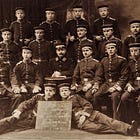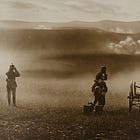In 1900, the German Empire sent an expeditionary force to China to take part in the international effort to suppress the Boxer Rebellion. On 10 November of that year, an American participant in that effort, Lieutenant Colonel Joseph T. Dickman of the 26th Infantry, wrote a description of this formation. This report was originally published by the Adjutant General of the US Army in Reports on Military Operations in South Africa and China (Washington, DC, 1901).
Sir: ... I have the honor to submit the following report of the German troops at present serving in North China:
On the 26th of August, 1900 the … German troops at Pekin consisted of ... one battalion of marine infantry of 1,000 men, and 200 sailors from the Hansa. Captain Pohl of the German Navy, as senior officer, commanded this force until the arrival of General von Hoepfner about September 1. On September 11 the German commander claimed to have 2,000 men and 6 guns in or near Pekin. At the time of Field Marshal von Waldersee's arrival at Pekin, October 17, the German forces in China consisted of the following:
First East Asiatic Infantry Brigade, consisting of the first and second regiments each of eight companies with a ... ninth company for duty on the line of communications.
Second East Asiatic Infantry Brigade (3rd & 4th Regiments).
Third East Asiatic Infantry Brigade (5th & 6th Regiments).
East Asiatic Cavalry Regiment (4 squadrons). East Asiatic Field Artillery Regiment, consisting of three Abteilungen of three batteries each.
East Asiatic pioneer battalion (3 companies) . East Asiatic railway battalion (3 companies).
One ammunition column Abteilung, reinforced by: 2 infantry ammunition columns, 2 artillery ammunition columns, 2 field howitzer ammunition columns, 3 supply columns, 6 field hospitals, 1 field bakery column, 1 horse depot, 1 lines-of-communication ammunition column, and 1 clothing depot
1 hospital ship
Also the original force of
2 battalions of marine infantry
1 pioneer company
1 battery, old model guns, 88mm
one fourth of a sanitary company
The commander of the forces is Lieutenant General von Lessel, stationed at Tienstin, Field Marshal Count von Waldersee, with headquarters in Pekin, being commander of the allied troops in China, with Major General Gross genannt von Schwarzhoff as chief of staff.
The Germans have their troops in quarters, none under canvas. ... When the Russians withdrew they made over their buildings, gates, etc. to the Germans.
Note: Readers interested in the Boxer Rebellion will probably enjoy the classic film 55 Days at Peking.
For Further Reading:












